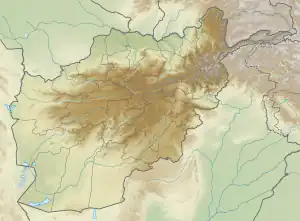Kuh-e Bandaka
Kuh-e Bandaka (Pashto: کوه بندکا) or Kohe Bandaka, Koh-i Bandaka, Bandako, or incorrectly Koh-i-Bandakor[3][4]) is one of the highest peaks of the Hindu Kush mountain range in northeastern Afghanistan. It is northeast of Kabul and west of Chitral. Separated by a relatively low pass from the core of the Hindu Kush, it is the second highest mountain entirely within Afghanistan,[3] and the most topographically prominent peak in all of Afghanistan.[1]
| Kuh-e Bandaka | |
|---|---|
 Kuh-e Bandaka Location in Afghanistan | |
| Highest point | |
| Elevation | 6,812 m (22,349 ft)[1][2] |
| Prominence | 2,834 m (9,298 ft)[1] Ranked 118th |
| Isolation | 75 km (47 mi) |
| Listing | Ultra |
| Coordinates | 36°10′45″N 70°59′00″E[1] |
| Naming | |
| Native name | کوه بندکا (Pashto) |
| Geography | |
| Location | Afghanistan |
| Province | Badakhshan |
| Parent range | Hindu Kush |
| Climbing | |
| First ascent | 1960 by Wolfgang von Hansemann, Dietrich Hasse, Siegbert Heine, and Johannes Winkler[3] |
| Easiest route | Glacier/snow climb |
On September 22, 1960, the second German expedition to visit the Hindu Kush made the first ascent of Kuh-e Bandaka. The members of the expedition were Wolfgang von Hansemann, Dietrich Hasse, Siegbert Heine, and Johannes Winkler, all from West Berlin; all attained the summit. They made four camps, with their base camp in the Dare-Sachi Valley at an altitude of 4,100 m (13,451 ft). The expedition also made multiple first ascents in the Pagar Valley of the Hindu Kush, and made meteorological and geological observations and sketch maps.[3]
There have been over fifteen subsequent ascents, via a variety of routes; however there have been no recorded ascents since 1977.[5]
References
- Afghanistan ultra-prominent peaks on peaklist.org
- Some sources, e.g. the Himalayan Index, give 6843 metres; the AAJ 1961 article gives 6660 metres.
- Siegbert Heine, "Berlin Hindu Kush Expedition", American Alpine Journal, 1961, p. 418.
- Robin Hartshorne, "Bandako", American Alpine Journal, 1966.
- Himalayan Index (Alpine Club)